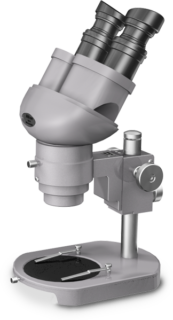Nikon’s Museum of Microscopy
Stereoscopic Microscope Model SM-6
( Circa 1972 )
As a follow-up to the highly successful SM-5 stereoscopic microscope of the 1960s, Nikon produced the SM-6 in the early 1970s. The instrument features 60-degree inclined eyepiece tubes and a choice of optional gliding stages for scanning or orienting specimens.

Rotatable through a full 360 degrees in either direction, the microscope head can be fixed in any position for viewer comfort with the microscope head lock-screw. Eyepieces are inclined inward about 10-degrees to each other and interpupillary distances range from 55 millimeters to 75 millimeters. The eyecups prevent extraneous light from entering the eyes of the observer, while maintaining the proper eye position for scanning the entire field of view.
A coarse and fine positioning rack is mounted on the column that supports the microscope body. When the coarse focusing clamp is loosened, the microscope head slides up or down the pillar for a working distance of about 100 millimeters. For observation, objects are placed on the stage or beneath the microscope base, which facilitates imaging of heavy or large specimens without having to remove the head from the pillar. Fine focus is adjusted by rotating either of the designated knobs for a range of about 40 millimeters.
Optics for the stereoscopic microscope include a pair of 2x magnification objectives, each with two lens groups, a pair of erecting prisms, and a pair of 10x magnification eyepieces. A diopter correction in the left-hand ocular lens allows the microscope optics to be matched to each observer. For versatility, the objectives at the bottom of the microscope head can accept a variety of accessories such as the SM illuminator for episcopic illumination, a cap analyzer, or a half-reflecting mirror.
Today the SM-6 has been succeeded by instruments in Nikon's SMZ series of stereomicroscopes.













